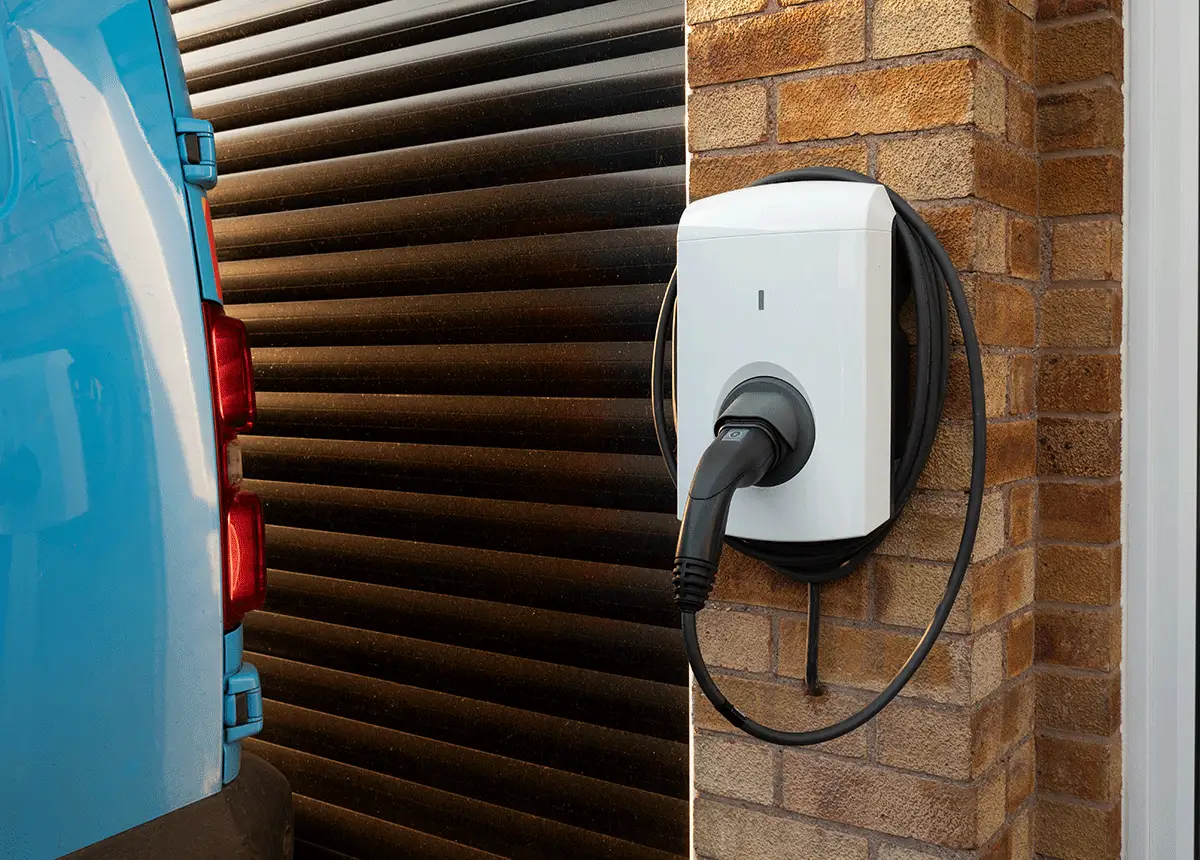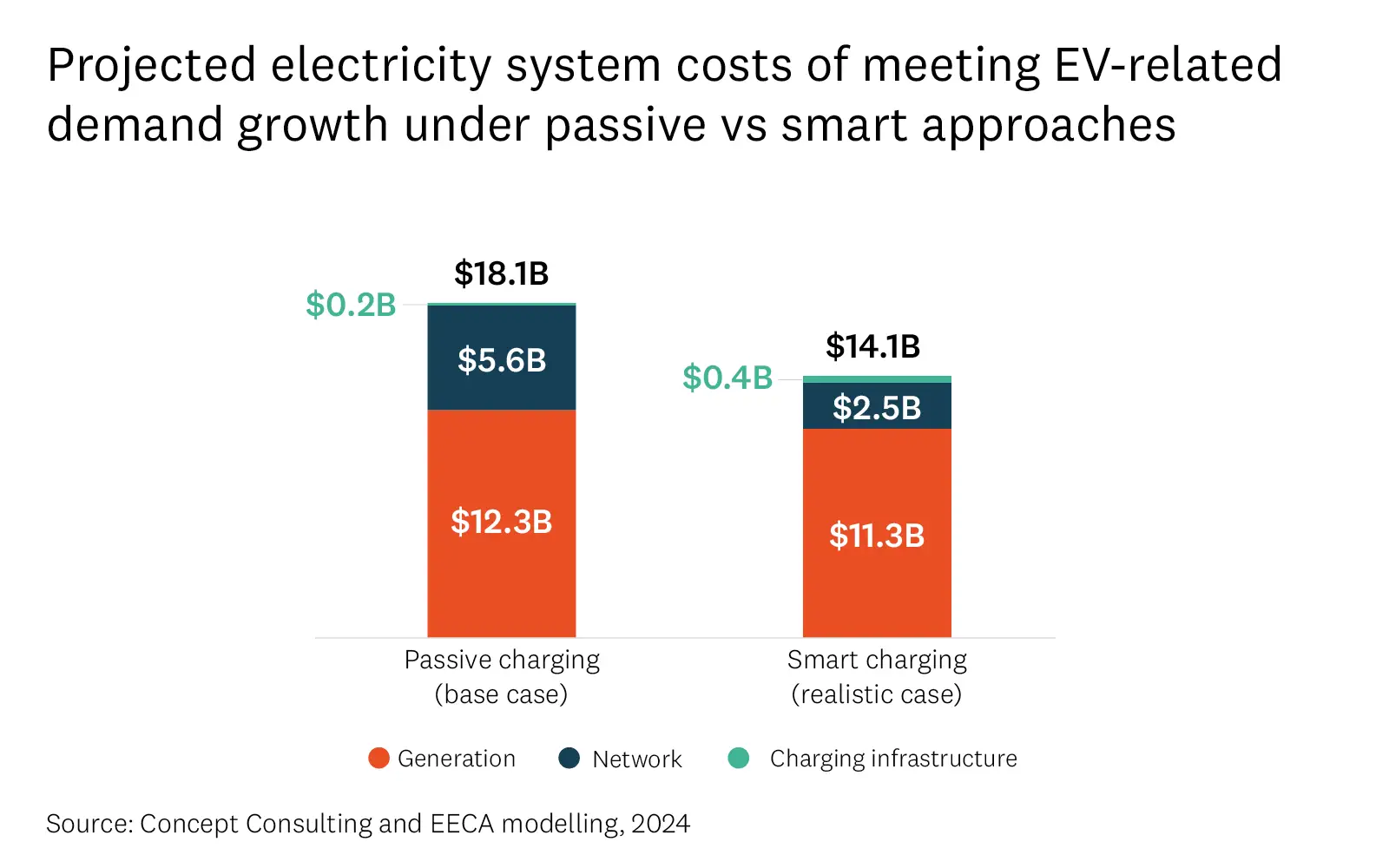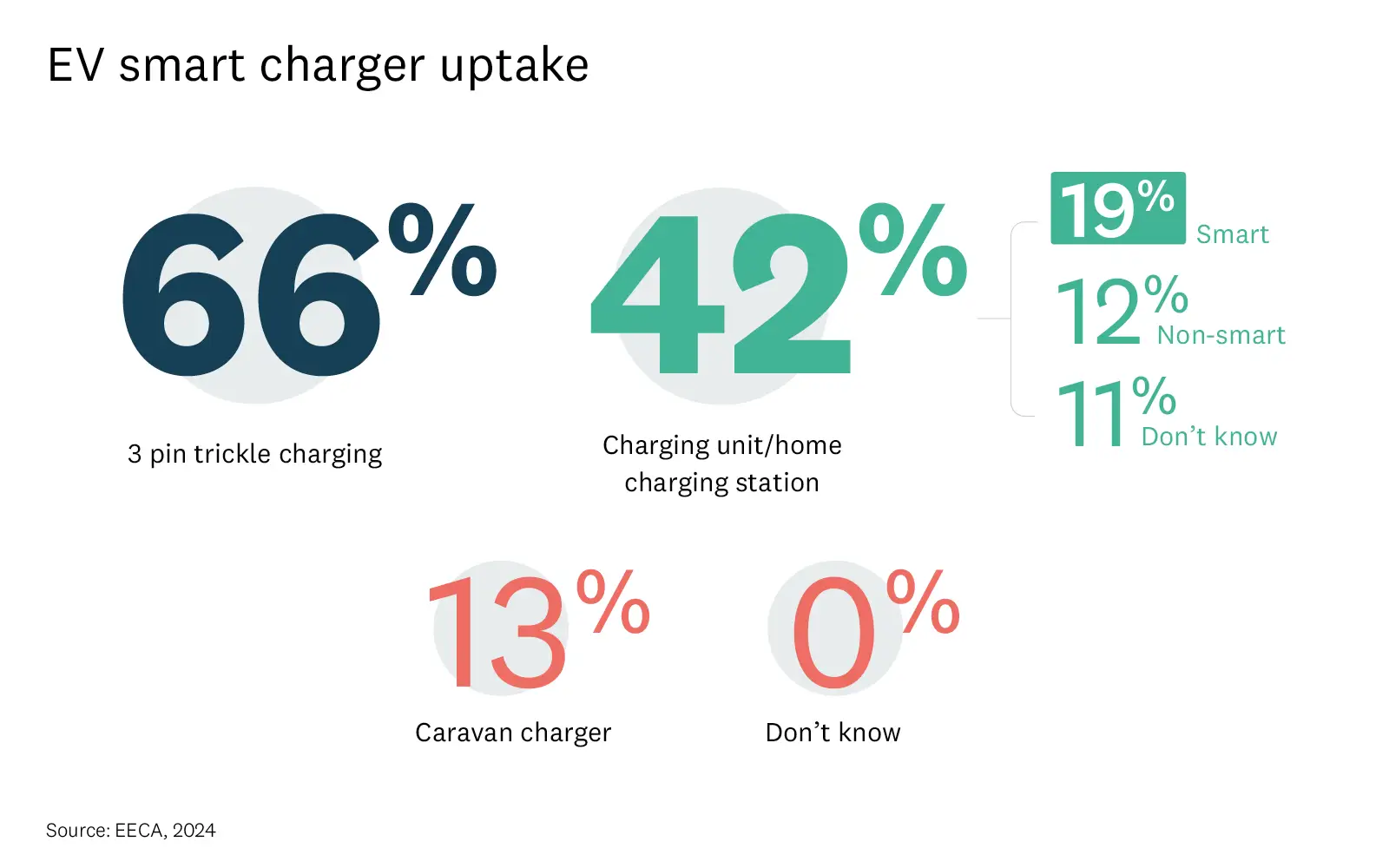The growth of electric vehicle ownership in New Zealand is happening during a time of increasing electricity demand. Our population is growing, and our industries, transport and homes are transitioning from fossil fuels to renewable energy sources like electricity.
How this growing demand is managed will impact investment in energy generation and enhancements to transmission and distribution networks, and ultimately how much consumers pay for electricity.
Home smart chargers are one technology that can help to effectively manage the increased peak electricity demand that comes from private electric vehicles.
Widespread use of smart chargers could save billions on grid infrastructure
Home smart charging has the potential to enable a more optimised approach to growth of New Zealand’s electricity generation, transmission and distribution, as well as save EV owners money on their energy costs.
Recent modelling suggests that widespread use of smart chargers could save $4 billion in network costs by 2050.
What is a smart charger?
Smart chargers are a class of EV charger that have a more advanced set of features and higher charging capacity than standard 3-pin chargers that are typically sold with an EV.
They feature built-in capability to communicate with the electricity grid, smartphones and smart home energy management systems. As a result, they can automatically adjust EV charging to increase or decrease electricity supply in response to external cost signals or remotely respond to the owner’s charging needs.
Charging preferences can be set for:
- The level of charge you want your battery to have.
- The time of day you want your charge completed.
- Under what conditions charging should be interrupted or slowed down.
Some wall mounted chargers available on the market do not have smart charging capability – and while these may allow for faster charging, their inability to communicate with the electricity grid means they do not offer the same capacity to automatically respond to electricity pricing and grid demand.

Advantages of smart chargers for EV owners
- Faster home charging – Smart EV chargers tend to have higher capacity (3.6-7 kW) than the standard 3-pin plug chargers (up to 1.8kW) that come with EVs. This means that they can charge EVs at least three times faster than a standard 3-pin charger.
- Automated off-peak charging – Smart chargers react to a signal to charge based on the parameters programmed in by the user, such as minimum charge capacity and cost. This allows users to take advantage of lower off-peak electricity prices. Off-peak rates encourage consumers to shift their energy consumption to quieter times, such as nights and weekends, when the grid is under less strain.
- Smart features – Smart chargers have features which enable wifi and mobile access to the charger and the ability to control and monitor charging on phones via an app, as well as the potential to integrate into a home energy management system (HEMS). This can help optimise users’ charging by evaluating the battery’s state of charge (SoC), power prices and driver needs, rather than a simple “set and forget” charging regime. When paired with a HEMS, further factors can be automated and optimised such as use of and mix of rooftop solar generation and storage for charging.
- Convenience and easy integration – EV owners are not likely to notice that their EV is being charged ‘smartly’. For example, analysis of over one million home charging sessions in the United States found that drivers typically plug their vehicle in for over 12 hours, but the actual charge time is less than 2.5 hours. This provides plenty of opportunity for EV owners to let their smart charger optimise time-of charging during off-peak times that occur over the 12-hour period, to help manage the network with no impact on them.
- Can easily be disabled – If EV owners do not want their car to be charged smartly, for example if their battery is very low and they have a big drive scheduled, they can opt to turn the smart charging off, and charge their EV at maximum capacity
- Future-proofs charging – A number of chargers entering the market have vehicle-to-grid (V2G) and vehicle-to-home (V2H) capability. This technology turns EVs into a ‘virtual power plant’. It allows the harnessing of EV batteries to provide power to the owner’s home, or to sell it back to the grid. This has the potential to save owners money and increase their home energy resilience. Some smart chargers are V2G and V2H capable now, though owners will not be able to use this feature in New Zealand immediately. Those who use V2H capability in other countries use it to save money by charging their car with cheap off-peak power and using it to power their homes during peak times.
The cheapest way to charge
Charging at home is the cheapest and most convenient way to charge an EV. The vast majority (80%) of people charge their EV at home more than half of the time.
Generally, home charging gives EV owners access to cheaper power than what is found at public charging stations, which is, on average, around twice the price.
Charging EVs during off-peak hours at home can save owners even more, with some retailers and electricity distribution companies (EDBs) offering off-peak power that is around 40% cheaper than standard rates.
Recent research conducted by EECA found that off-peak plans are available to 69% of EV owners, through their home electricity retailer. Among those EV owners that have access to off-peak power, nearly all (96%) of them utilise it for charging some, or most of time, indicating that many owners are already capitalising on this savings opportunity.
Smart charging technology can ensure that these off-peak savings are being captured consistently, helping to keep energy bills lower.
How smart chargers manage household peak demand
Smart charging technology can help alleviate pressure on the electricity grid. Smart EV chargers can facilitate flexible and optimised charging of EVs, by responding to signals such as:
- energy prices
- electricity system capacity
- electricity system demand and congestion
- EV battery status
- consumer charging needs
Smart chargers can lower the electricity demand for EV charging during peak periods and times where there is congestion on the local network such as winter and early evenings. At the same time, they can ensure that EV owners’ charging needs are met by shifting the charging load to off-peak times.
Smart EV chargers provide a great entry point for consumers to start thinking about their home’s total energy consumption and how best to manage this. As time goes on there will be greater opportunity to adopt additional smart devices into homes.
The chart below demonstrates the impact of ‘smart’ vs ‘passive’ or ‘non-smart’ charging on a household, and the ability to flatten household demand from what could be considered a ‘peak load’ of 2.5kW to a load of 1.6kW. The ‘passive’ scenario on the left assumes that most charging is done during peak hours of 5pm to 9pm, when people are home from work or their main daily activities.
Transpower estimates that widespread uptake of smart EV charging would reduce New Zealand’s winter evening demand peak by 1.9GW (18%) by 2035 compared to unmanaged EV charging.
Whakamana I Te Mauri Hiko Empowering our Energy Future, Transpower report, March 2020
The importance of smart chargers at a system level
At scale, household decisions, such as whether to buy a smart charger, can have a huge impact on managing our national electricity demand.
In future, smart chargers may allow for system-level energy management, to ensure EV charging is managed against other energy demands. This will help minimise the need for fossil-fuel powered peaking generation, such as that of Huntly power station, which will help reduce emissions from electricity production and use.
Overall, Transpower predicts that electricity demand will increase by 68% by 2050. How this demand is managed will have significant impacts on the investment in renewable energy generation and enhancements to transmission and distribution networks that will be needed to keep pace.
Impact on electricity generation and network needs
An EV can typically increase household electricity demand by around 20-30%.1 Smart residential EV charging has the potential to manage demand at a system level during peak demand periods, which will reduce the need for investment in both network upgrades and peaking generation that would otherwise be required to meet this demand in a passive EV charging scenario.
1Modelled from Ministry of Transport fleet data and average energy consumption for EVs; and New Zealand household electricity consumption data from MBIE and the Electricity Authority.
Peaking vs baseload generation
The type, cost and emissions factor of electricity generation to meet the predicted increase in electricity consumption from EV charging will be strongly driven by the pattern of EV charging and whether it occurs during times of national peak or off-peak demand.
- Peaking generation – EV charging which occurs at times of peak demand will create a need for increased ‘peaking’ generation. This is generation which is required relatively infrequently to meet peak demand, usually during winter during early evening when demand is at its highest. In New Zealand, this is predominantly from fossil fuelled gas and coal-fired generation, which is both more expensive, and has a higher emissions factor than our renewable ‘baseload’ generation.
- Baseload generation – EV charging which occurs during off-peak periods will predominantly be met by increased ‘baseload’ generation. This is generation which operates almost continuously and tends to be used during off-peak demand hours. In New Zealand, the most economic form of new baseload generation is renewable power in the form of wind or geothermal power stations.
Network capacity and upgrade requirements
A significant portion of network costs stem from meeting peak electricity demand. Flattening these peaks – for example, through the widespread use of smart EV chargers – reduces the need for transmission and distribution upgrades.
The costs of the network are not significantly influenced by the volume of kWh flowing through it at any given moment. Instead, costs associated with demand are primarily driven by the peak kilowatt (kW) demand on the network.
- Each network has a maximum or ‘peak’ capacity it can deliver.
- If the peak demand on a network continues to rise, for example, if local EV charging demand is ‘passively’ charged during peak hours, it may eventually surpass this capacity limit.
- Network operators aim to prevent capacity limits from being exceeded by proactively investing in additional transmission and distribution capacity.
- Limiting actual or expected rises in peak demands means that the existing network can meet our needs for longer, and any expansions needed will be smaller and cheaper.
Driving savings for New Zealand
When comparing mass-adoption of smart chargers over a longer time frame to 2050, the cost-saving potential of this technology compared to the alternative is stark.
It is estimated that by 2050, EV-associated peak demand will be nearly two and half times higher (3,277 MW) in a passive charging scenario, compared to a charging scenario managed by mass-uptake of smart chargers (1,341MW).
This has significant implications for all electricity users and suppliers, with the passive charging scenarios requiring much higher investment in network assets and generations, and likely leading to lower system security, higher and more volatile energy prices, and potentially delaying uptake of other electrification activities such as industrial process heat or heavy transport.
Smart charging could save $4 billion in network costs by 2050
In the scenarios modelled above, smart charging could reduce EV-related generation, transmission and network costs by around $4 billion by 2050.
Avoiding large and rapid investment in system peak capacity means that not only will costs be lower, but the investment that does take place is likely to be better planned and more resilient to future needs.
Avoiding or deferring some network upgrades means that the associated costs would not be cascaded to the consumer through large increases to their power bills. In fact, if extra energy demand can be delivered through existing networks, the average cost of delivered electricity could fall for all consumers.
Given the strong relationship between EV adoption and our electricity infrastructure, if smart chargers are widely adopted, they have the ability to help manage the electrification of our transport and help improve the affordability, reliability, and security of our underlying grid, for the greater good of all New Zealanders.

New Zealand smart charger uptake
Recent research conducted by EECA (2024) has found that smart charger uptake remains low among New Zealand’s EV owners. Among the 42% of EV owners who have a wall-mounted charging unit, 19% claim to have a smart charger, 12% a non-smart charger, and 11% did not know.
Standard 3-pin plug chargers are still used by a majority (66%) of EV owners, meaning that there is substantial potential for greater adoption of wall-mounted smart chargers.
In addition, 12% of EV owners claim to have installed non-smart wall-mounted chargers without connectivity. This means a sizable portion of EV owners who are going through the expense of purchasing a wall-mounted charger, could purchase a smart charger instead, for minimal extra cost.

Smart charger market
There are a wide range of smart chargers on the market in New Zealand, and the options are increasing. Currently, EECA is aware of approximately 20 to 40 EV residential wall box charger models available. Around half of these are marketed as having ‘smart’ functionality that offers a wide a range of different features. Purchasing a smart wall mounted charger, instead of a wall-mounted charger with no connectivity, ensures that home charging is future-proofed at minimal extra cost and will enable significant future benefits.
EECA-approved list of smart chargers
There is currently a lack of consumer certainty around what constitutes a ‘smart’ charger, as features can vary from device to device.
EECA has published an approved list of smart EV chargers recommended for residential and commercial use. The approved list has been developed to help New Zealanders identify, and purchase, smart and efficient EV chargers.
To be included on the approved list, chargers need to be efficient and capable of two-way communication (smart), based on our technical specification.
Read next
-
Buying a smart EV charger
Home smart chargers are the best option for keeping your EV charged and ready for use.
-
Plugging into the future: How New Zealand is electrifying its roads
An overview of public EV charging infrastructure in New Zealand.
-
The impact of electric homes
A technical assessment of the energy, economic, and emissions opportunity when electrifying New Zealand households and garages.





